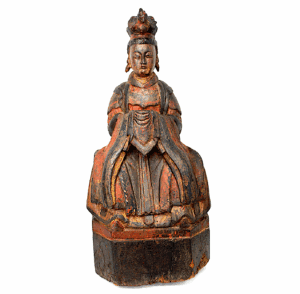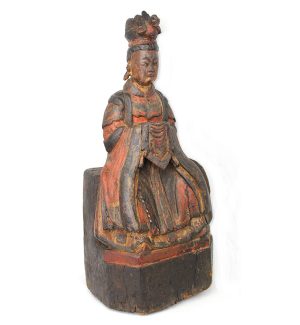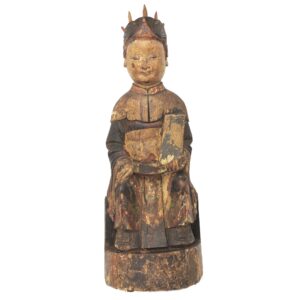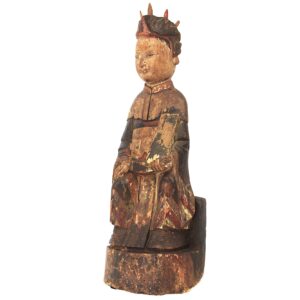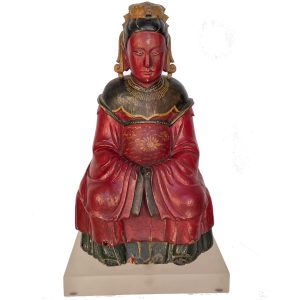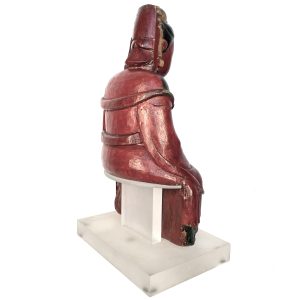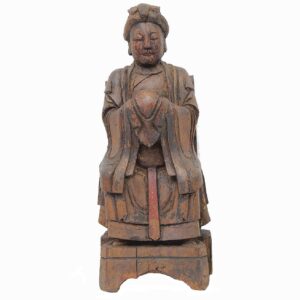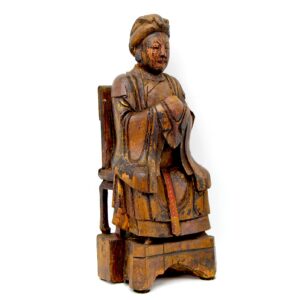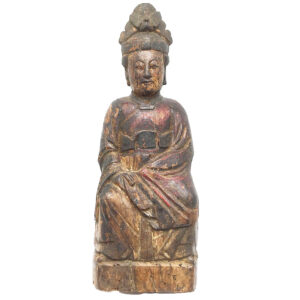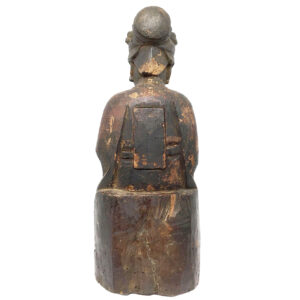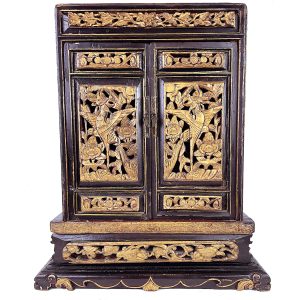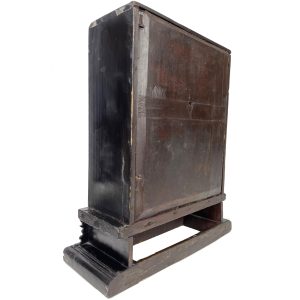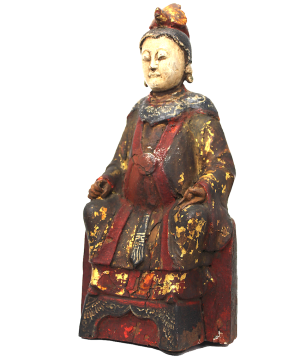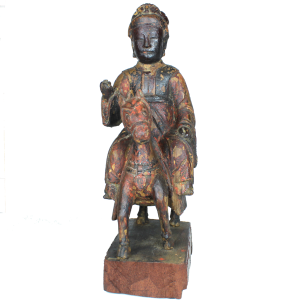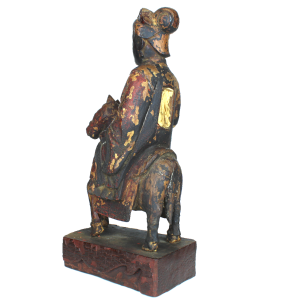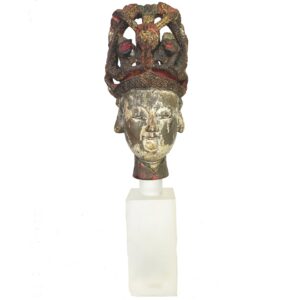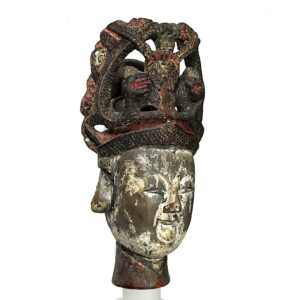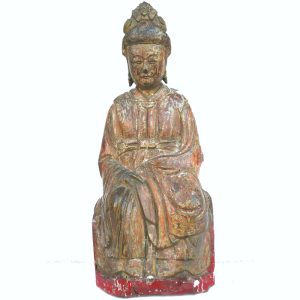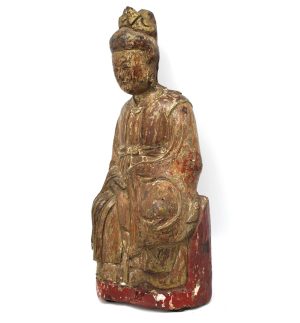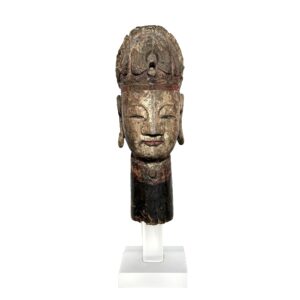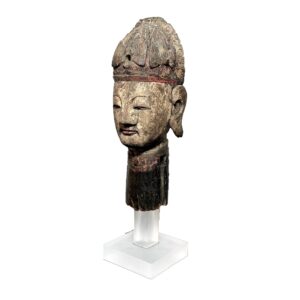Showing 1–12 of 13 results
-
Sale!


$275.00 Original price was: $275.00.$225.00Current price is: $225.00.
Finely carved from dense wood Mazu is the Heavenly Empress on a horseshoe chair, holding official’s girdle, phoenix hat with outstretched wings and cloud collar symbolizing her place in heaven.
-
Sale!


$1,550.00 Original price was: $1,550.00.$1,275.00Current price is: $1,275.00.
H: 17.25″ W: 8″ D: 6″ CALL 213-568-3030 OR EMAIL [email protected] FOR SHIPPING.
Exquisite carved Queen Mother of the West, elaborate phoenix in crown. Most significant Taoist female deity, patron of women, divine teacher, determines length of people’s lives, associated with virtue and peaches of immortality.
-
Sale!


$495.00 Original price was: $495.00.$325.00Current price is: $325.00.
H: 12 ” W:4.3 ” D: 2.25 ” | FREE SHIPPING WITHIN CONTINENTAL U.S.
Charming consecrated image of female Toast priest with Phoenix headdress holding a hu tablet. Women were welcomed as priests since Taoism beginnings.
-
Sale!


$1,750.00 Original price was: $1,750.00.$1,150.00Current price is: $1,150.00.
H: 21” W: 11.5” D: 8” | FOR SHIPPING call 213-568-3030 or email [email protected]
Temples for “Heavenly Empress” Mazu in southern China coastal regions protect sea faring peoples. This motherly home altar statue reflects that although childless, she protects her children – her devotees – as a mother. Seated on lucite base.
-
Sale!


$425.00 Original price was: $425.00.$225.00Current price is: $225.00.
H: 9” W: 6.525” D: 2.5 | FREE SHIPPING WITHIN CONTINENTAL U.S.
Small consecrated home altar provincial Mazu, finely carved on armless back chair dressed modestly in peasant robes with a phoenix in her hat, she is motherly figure who protects her devotees as her children.
-
Sale!


$395.00 Original price was: $395.00.$315.00Current price is: $315.00.
H: 12.5″ W: 4.8″ | 3.3″ FREE SHIPPING WITHIN CONTINENTAL U.S.
Home altar provincial Queen Mother carving depicted her as approachable, humble and matronly. Iconic phoenix on headdress. Cavity with original sealed covering indicates it was consecrated.
-
Sale!


$595.00 Original price was: $595.00.$425.00Current price is: $425.00.
H: 16.375″ W: 13.625″ D: 5.75″ | FOR SHIPPING INFORMATION CONTACT US AT 213-568-3030 or [email protected]
Extremely ornate black lacquer cabinet with intricately carved doors, and gilded openwork panels with opening to red lacquer, gilt fringe interior with backdrop with Chinese scenes. Display of status and piety, designed as dignified display for honoring ancestral spirits.
Intricately carved black and heavily gilt cabinet is a fine example of a Straits Chinese furniture Carved openwork panels with phoenixes and lotuses are symbolic wishes for harmony, blessings, rank, good fortune; outstretched wings wish for harmonious marriage, many sons and the inside decoration a wish for status and successful career. Although somewhat flamboyant, it is a unique accent piece and great gift for newly weds.
-
Sale!


$585.00 Original price was: $585.00.$395.00Current price is: $395.00.
H: 11.5″ W: 5.3″ D: 4.2″ | FREE SHIPPING WITHIN CONTINENTAL U.S.
Provincial carving with iconic phoenix headdress, hands in karana mudra to cast out demons, negative energy and purify spaces. Image was on home altar and consecrated with a sealed cover.
-
Sale!


$625.00 Original price was: $625.00.$495.00Current price is: $495.00.
H: 14.75″ W: 5.25″ D: 6.8″ | FREE SHIPPING WITHIN CONTINENTAL U.S.
By making the Queen Mother larger than her horse and adorning it with decorative accessories – wide blanket, prominent head gear, double rowed harness, decorative medallion – this provincial artist emphasizes her power as Tao goddess of life, fertility and granting immortality.
-
Sale!


$785.00 Original price was: $785.00.$495.00Current price is: $495.00.
Ht: 17” W: 4.25” D: 4.5” | FREE SHIPPING WITHIN CONTINENTAL U.S.
Very rare depiction of Queen Mother of the West puppet head wearing elaborate headdress with outstretched tortoise legs atop a phoenix, reflecting early shamanism rites of turtle shell divination. Mounted on acrylic base.
-
Sale!


$525.00 Original price was: $525.00.$295.00Current price is: $295.00.
H: 11.25″ W: 4.6″ | 3.25″ FREE SHIPPING WITHIN CONTINENTAL U.S.
Dense hardwood Queen Mother carving with phoenix in crown, holding robe across body, calmly seated on backless throne, much original polychrome and lacquer finish remains. Sealed consecrated cavity.
-
Sale!


$625.00 Original price was: $625.00.$495.00Current price is: $495.00.
H:14.75″ W: 4″ D: 4.5″ | free shipping within continental US
Antique Xiwangmu puppet head with 3 phoenixes in crown, traditional Qing head ware worn by the Empress for official occasions, ceremonies. Acrylic stand.
End of content
End of content



